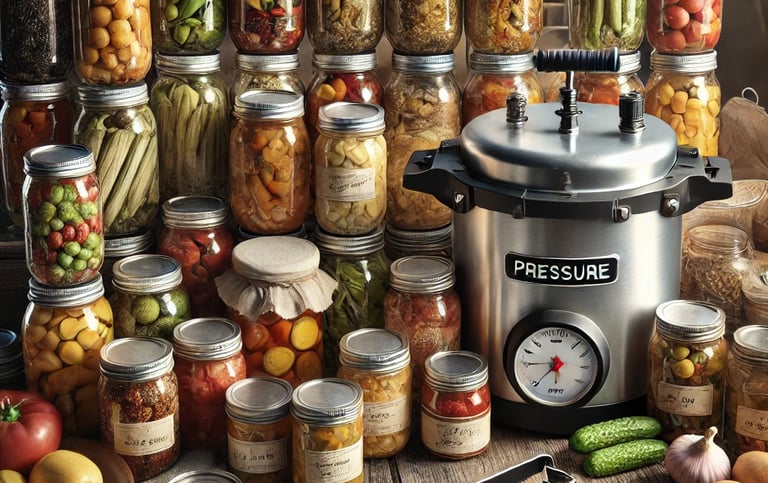Essential Emergency Canning Supplies: What You Need to Know
Discover essential emergency canning supplies and learn how to preserve food safely. Stock up on jars, tools, and tips to ensure your preparedness for any crisis.
FOOD PRESERVATION
As an Amazon Associate, I earn from qualifying purchases. This means I may earn a commission if you click on an affiliate link and make a purchase, at no extra cost to you.


Disclaimer:
This article provides an overview of canning basics but is not a substitute for professional canning guidelines. Always research current canning safety practices and follow the manufacturer’s instructions on your canning equipment to ensure safe, effective food preservation.
1. Why Canning Matters for Emergencies 🥫
In times of crisis, fresh food supplies can become limited, and store shelves might empty quickly. Canned foods have an extended shelf life, allowing you to store nutrient-rich options for long periods. They don’t rely on electricity, making them ideal for power outages. Unlike dehydrated foods, canned goods maintain moisture and are ready-to-eat, making them practical and versatile in an emergency.
2. Essential Canning Equipment You’ll Need 🔧
Before you start, make sure you have the following canning essentials:
Canning Jars and Lids: Choose jars designed for canning, as regular glass jars can crack under heat.
Pressure Canner: Essential for canning low-acid foods like meat and vegetables to prevent bacterial growth.
Water Bath Canner: Suitable for high-acid foods, such as fruits, jams, and pickles.
Jar Lifter: A helpful tool for safely lifting hot jars out of boiling water.
Food Prep Tools: Funnel, bubble remover, and clean cloths for wiping jars.
Each tool has a specific purpose, so having the correct equipment ensures your canned food will be safe and shelf-stable.
3. Types of Foods to Can for Emergencies 🍲
Certain foods are ideal for long-term canning and survival situations:
Vegetables (beans, carrots, peas): Canned vegetables add essential nutrients and are versatile in recipes.
Fruits (peaches, apples, berries): High-acid fruits work well with water bath canning and are easy to prepare.
Proteins (meats, fish, legumes): Protein-rich foods are especially valuable in emergencies. Canning meats requires a pressure canner but ensures you have a complete meal source.
Complete Meals (stews, soups, chili): These options are quick to reheat and consume, making them practical when you need fast, nutritious meals.
Canning a variety ensures you’ll have balanced nutrition options available when fresh food is unavailable.
4. Step-by-Step Guide to Pressure Canning 🥕
Pressure canning is required for low-acid foods to eliminate botulism risk. Here’s a quick guide to safe pressure canning:
Prepare Jars and Ingredients: Clean and sanitize jars, lids, and canner. Pre-cook ingredients if needed (for example, browning meat).
Fill Jars: Pack hot food into jars, leaving headspace (usually about 1 inch). Remove air bubbles and clean rims.
Seal Jars: Place lids and rings on jars. Tighten just until snug; over-tightening can prevent a proper seal.
Place in Pressure Canner: Arrange jars in canner with water at the correct level. Secure lid and heat until you achieve pressure.
Process According to Instructions: Follow your canner’s instructions for pressure and time based on the food type and jar size.
Cool and Check Seals: Let the canner cool before removing jars. Check seals by pressing the lid – it should not pop back. Reprocess or refrigerate unsealed jars.
5. Water Bath Canning for High-Acid Foods 🍑
High-acid foods, like fruits and pickles, can be canned with a simpler water bath process:
Prepare and Pack: Pre-cook or slice fruits, adding syrup or juice as desired. Fill jars, leaving about 1/2 inch of headspace.
Process in Water Bath: Place jars in a water bath canner and ensure water covers jars by at least 1 inch. Boil according to your recipe’s time chart.
Cool and Store: Remove jars and let cool. Check seals after 12-24 hours. Store sealed jars in a cool, dark place.
Water bath canning is quick and effective, ideal for beginners.
6. Key Safety Tips to Keep in Mind ⚠️
Use Trusted Recipes: Canning times and methods vary by food type. Always follow a reliable source for safe canning times.
Check Seals Regularly: A properly sealed jar will have a concave lid. Discard any jars with bulging lids or visible signs of spoilage.
Store Properly: Keep canned goods in a cool, dark, dry place. This ensures maximum shelf life and retains nutrient quality.
7. Storage and Shelf Life: How Long Will Canned Foods Last? ⏳
Canned foods can last anywhere from 1 to 5 years, depending on storage conditions. Ideal storage temperatures are between 50-70°F, away from direct sunlight. Regularly inspect your jars for signs of spoilage, and rotate stock for best use. High-acid foods generally last 1-2 years, while low-acid foods (meats, vegetables) can safely last 3-5 years if sealed and stored properly.
8. Practical Tips for Preppers: Creating a Canning System 🛠️
Label Everything: Include the date, contents, and canning method used on each jar. This will help you track shelf life and prioritize what to use first.
Organize by Food Type: Keep proteins, fruits, vegetables, and complete meals together to make meal planning easier.
Practice Rotation: Use the oldest jars first and can new batches to refresh your stock. This ensures minimal waste and keeps your emergency supply at optimal quality.
Conclusion
Canning is a valuable skill for anyone serious about emergency preparedness. Not only does it allow you to have control over your food supply, but it also helps maintain nutrition and peace of mind in times of crisis. With a little practice and the right equipment, you can turn fresh produce and meats into long-lasting food staples that will serve you and your family well when the unexpected strikes.
Helpful Resources for Safe Canning
For more detailed information on safe canning practices, consult these trusted sources:
National Center for Home Food Preservation – https://nchfp.uga.edu
USDA Complete Guide to Home Canning – https://nifa.usda.gov/resource/usda-complete-guide-home-canning
Ball Canning – https://www.ballmasonjars.com/canning
University Extension Canning Resources – https://extension.psu.edu/food-safety/canning
